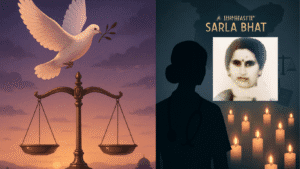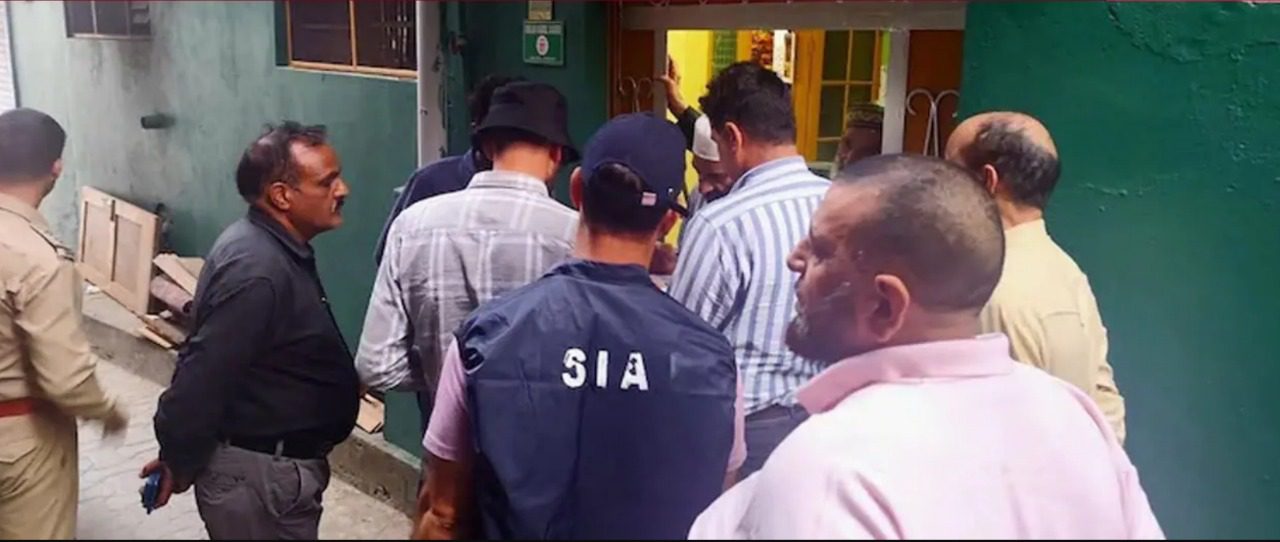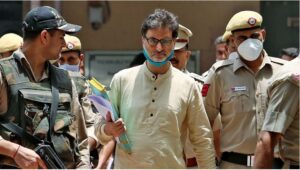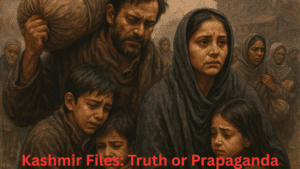In a coordinated pre-dawn operation, the Jammu and Kashmir State Investigation Agency (SIA) launched eight simultaneous raids across Srinagar. The targets were individuals suspected of involvement in the 1990 abduction, torture, and murder of Kashmiri Pandit nurse Sarla Bhat.
The Sarla Bhat Case has haunted the Kashmiri Pandit community for over three decades. Sarla’s killing was one of the most brutal acts of the early insurgency period, carried out by members and associates of the Jammu and Kashmir Liberation Front (JKLF). For years, the investigation languished. This latest move represents the most significant step toward justice since the day her body was found.
Complete List of SIA Raids and Targets on Sarla Bhat Case
The targets weren’t random. Instead, they were carefully selected individuals with alleged connections to the Jammu and Kashmir Liberation Front (JKLF). Moreover, many had links to the notorious HAJY Group, a terror faction that terrorised Kashmir’s valleys in the early 1990s.
But who precisely did they target? The list reads like a roster of forgotten nightmares:
- Javaid Ahmad Mir alias Nalka from Chamardori Zainakadal
- Peer Noor ul Haq Shah alias Air Marshal from Illahi Bagh Bachpora
- Reyaz Kabir Sheikh from Danderkah Batamaloo
- Bashir Ahmad Gojri from Kadikadal Soklipora
- Feroz Ahmad Khan alias Jan Mohammad from Sazgaripora
- Kaiser Ahmad Tiploo alias Raj Tiploo from Al Hamza Colony Ahmadnagar
- Ghulam Mohammad Taploo from Tiploo Mohalla Anchar
Each name carries weight. Each address holds memories. Each raid signals that the past isn’t buried yet.
What Did These Raids Achieve?
The investigators didn’t come empty-handed. They seized documents, digital storage devices, and personal correspondence. Now, forensic experts will examine every piece of evidence. Will these materials finally unlock secrets that have remained hidden for over three decades?
Officials remain tight-lipped about potential arrests. However, they’ve indicated that the evidence collected could fill critical gaps. These gaps have kept the case dormant since 1990.
Think about it: In 1990, digital evidence didn’t exist. Mobile phones were rare. Social media was unimaginable. Today’s investigation has tools that weren’t available then. Consequently, old materials might reveal new truths.
The HAJY Group: Architects of Terror
Understanding Sarla’s murder means understanding her killers. The HAJY Group wasn’t just another militant faction. Instead, it was a calculated terror network that changed Kashmir forever.
The name came from its four leaders: Hamid Sheikh, Ashfaq Majeed Wani, Javed Mir, and Yasin Malik. Together, they formed a core within the JKLF. Their mission? To drive out Kashmir’s Pandit community through fear and violence.
To know about Hajy Group, read the article here
Their Methods Were Brutal and Systematic
The group didn’t randomly attack civilians. Rather, they targeted specific categories:
- Healthcare workers like Sarla
- Judges and lawyers
- Teachers and intellectuals
- Government employees
Because they represented the fabric of civilised society, furthermore, their murders sent a clear message: No Pandit was safe anywhere.
Between 1988 and 1990, the HAJY Group orchestrated numerous attacks. They were kidnapped for ransom and political leverage. They bombed government buildings. Most importantly, they created an atmosphere where simply being Pandit became dangerous.
Who Was Sarla Bhat?
Sarla wasn’t just a victim. She was a daughter, a professional, and a symbol of courage. Born in Anantnag, she grew up in a modest Kashmiri Pandit family. Education mattered to them. Helping others mattered more.
Sarla Bhat Case and SKIMS
After completing her nursing training, Sarla joined the Sher-e-Kashmir Institute of Medical Sciences (SKIMS) in Srinagar. Her colleagues remember her differently than the headlines might suggest. She was hardworking, yes. But she was also fearless in ways that seemed almost reckless.
Even as tension mounted in the Valley, Sarla refused to leave. Other Pandits were already fleeing. Threats were becoming commonplace. Violence was escalating daily. Yet she stayed at her post.
Why? Perhaps she believed in her duty to patients. Maybe she thought the madness would pass. Or possibly, she couldn’t imagine that her neighbors would turn against her so brutally.

The Night That Changed Everything
April 14, 1990. The date is seared into Kashmir’s collective memory. Armed JKLF terrorists stormed the nurses’ hostel where Sarla was staying. They didn’t come looking for any nurse. They came specifically for her.
Other nurses later described their horror. The men knew Sarla by name. They led her away at gunpoint. No police protection was available. In fact, law enforcement itself was under siege.
Reporting the incident was nearly impossible. Who could they call? Which authorities could be trusted? The state machinery had effectively collapsed in many areas.
Read about the article, that caused the genocide of Kashmiri Pandits
Sarla Bhat Case: Four Days of Torture
What happened during those four days remains difficult to document fully. However, survivor testimonies and reports from that period paint a horrific picture. Sarla was subjected to brutal torture. She endured repeated sexual violence.
This wasn’t random cruelty. Instead, it was calculated intimidation designed to terrorize the entire Pandit community. The message was clear: This could happen to your daughters, your sisters, your wives.
Sarla Bhat Case: The Final Act
On April 19, 1990, Sarla’s body was found in downtown Srinagar. She had been shot multiple times. Beside her lay a handwritten note accusing her of being a police informer.
The informer accusation was completely unfounded. Yet it served a purpose for the terrorists. It provided a veneer of justification for their brutality. Moreover, it warned others that any Pandit could be labeled as such.
The Humiliation Continued Even After Death
Sarla’s father, Shambu Nath Bhat, faced another nightmare when he tried to perform her last rites in Anantnag. Terrorists issued fresh threats to locals. They warned people not to attend the funeral.
Can you imagine? Even in death, Sarla couldn’t find peace. The funeral proceeded with only a handful of brave mourners. The act of mourning itself had become dangerous.
Indu Bushan Zutshi later documented this incident in his memoirs. He wrote about the suffocating fear that prevented even acts of basic compassion. This wasn’t just about killing Sarla. It was about killing humanity itself.
Read the article about the Sarla Bhat Case here
The Exodus: When Fear Became Reality
Sarla Bhat’s murder wasn’t an isolated incident. Rather, it was part of a systematic campaign that ultimately displaced over 300,000 Kashmiri Pandits from the Valley.
The Build-Up to 1990
The signs were there for those who chose to see them:
1986 Anantnag Riots: Widespread anti-Pandit violence erupted in southern Kashmir. Many families fled for the first time. However, most returned when tensions seemed to cool.
For what happened during the Anantnag Riots, read here
1987 Election Rigging: The controversial 1987 Election rigging in the state elections gave birth to radical movements. Many of these groups were openly hostile to Pandits. Democracy’s failure had created space for extremism.
1989-1990 Insurgency Surge: Armed groups began targeting Pandits systematically. Assassinations became common. Threats were delivered openly. Abductions increased in frequency.
By mid-1990, entire neighborhoods stood empty. Temples were abandoned. Schools shut down permanently. Properties were seized or destroyed without consequence.
The Human Cost
Numbers tell only part of the story. Over 300,000 people lost their homes overnight. Centuries-old communities vanished. Cultural heritage sites fell into ruins.
But what about the human cost? Families are separated permanently. Children grew up without knowing their ancestral homes. Elderly people died in exile, never to see Kashmir again.
The psychological trauma continues today. Second and third-generation Pandit refugees carry scars from events they never directly experienced. The pain travels through generations.
Thirty-Five Years of Waiting
Despite the brutality of Sarla Bhat murder case, the case remained largely dormant for decades. Many suspects evaded investigation entirely. Some moved abroad. Others lived openly in Kashmir, even participating in public events.
Why Did Justice Take So Long?
Several factors contributed to this delay, but the most disturbing truth remains largely unspoken:
Local Collaboration: Many locals were in cahoots with JKLF terrorists. They provided shelter, information, and protection to killers like those who murdered Sarla. When investigations began, these same people refused to come forward as witnesses. Some actively misled authorities.
Vote Bank Politics: Successive governments treated Kashmiri Pandits merely as a vote bank rather than as citizens deserving justice. Politicians made emotional speeches during elections but took no concrete action afterwards. The community’s displacement made them politically less relevant in Kashmir itself.
Climate of Fear and Complicity: The line between victim and collaborator became blurred in 1990s Kashmir. Many who witnessed crimes stayed silent not just from fear, but because they had enabled the violence. Speaking up would have exposed their complicity.
Political Instability: Kashmir remained a conflict zone for years. Normal policing became impossible. Case files got lost or neglected. But this instability was often convenient for those wanting cases buried.
Lack of Witnesses: Fear kept people silent, yes. But more troubling was how those who could have spoken – neighbors, colleagues, local officials – chose silence to protect the perpetrators they had helped.
Limited Technology: 1990s investigations relied on basic methods. DNA testing was unavailable. Digital forensics didn’t exist.
Jurisdictional Issues: Multiple agencies handled different aspects. Coordination was poor. Accountability was minimal. Often, this confusion seemed deliberately maintained.
The Uncomfortable Truth About Local Complicity
Here’s what many don’t want to discuss: Sarla’s killers didn’t operate in isolation. They had local support networks. Neighbours who provided information about her movements. Colleagues who may have revealed her schedule. Local officials who looked the other way.
When the SIA conducted raids in 2025, they weren’t just targeting the direct perpetrators. They were also going after the ecosystem that enabled the crime. This ecosystem of complicity explains why justice took 35 years.
Many who witnessed Sarla’s abduction knew her captors personally. They could have identified them immediately. Instead, they chose silence. Some actively misdirected investigations. Others disappeared when authorities came asking questions.
Why? Because admitting what they knew would expose their own roles in the tragedy.
Why These Raids Matter Now
The SIA’s operation represents more than just reopening a cold case. Instead, it signals a fundamental shift in political will. It acknowledges that historical wrongs must be addressed regardless of how much time has passed.
Legal Challenges Ahead
Such investigations face significant obstacles. Witnesses may be reluctant to speak after 35 years. Physical evidence might be degraded or destroyed. Memories fade and change over time.
However, modern forensic techniques offer new possibilities. Digital investigations can uncover leads from old materials. DNA analysis might provide crucial links. Financial records could reveal connections that weren’t apparent before.
The Message Being Sent
Beyond the legal aspects, these raids send important messages to multiple audiences:
To the Pandit Community: Your suffering hasn’t been forgotten. Justice may be delayed, but it’s not abandoned.
To Potential Witnesses: The state is serious about this case. Coming forward now might be safer than it was before.
To Other Suspects: Impunity has an expiration date. Time doesn’t wash away guilt.
Community Voices: Hope Mixed with Caution
The Pandit community’s response has been cautiously optimistic. One activist from Jammu explained: “Even if convictions are far off, this sends a message that the state hasn’t forgotten. For thirty-five years, we’ve been telling our children about Sarla’s courage and suffering. Now we can tell them that the law is finally listening.”
The Younger Generation’s Perspective
For young Pandits who never knew Kashmir, Sarla’s story has been passed down through family narratives. They know her name. They understand her sacrifice. But many had given up hope of ever seeing justice.
These raids have reignited something in them. Social media platforms buzzed with discussions. WhatsApp groups shared news updates. The case has become a symbol of their community’s resilience.
Learning from Global Examples
Kashmir isn’t the only place where justice has been delayed for decades. Around the world, several examples show that accountability can come even after long periods:
Nazi War Crimes
Trials for Holocaust-related crimes continued well into the 21st century. Some perpetrators were prosecuted in their 90s, decades after World War II ended. The principle was clear: certain crimes have no statute of limitations.
Rwanda’s Gacaca Courts
After the 1994 genocide, Rwanda pursued justice through both formal courts and traditional gacaca systems. Many cases were resolved years later. The emphasis was on truth, accountability, and reconciliation.
Argentina’s Military Dictatorship
Argentina prosecuted military officials for crimes committed during its 1976-1983 dictatorship. Many trials occurred decades later, after amnesty laws were overturned. The country chose memory over forgetting.
The Common Thread
These examples share important characteristics. First, political will eventually emerged to pursue justice. Second, communities refused to let crimes be forgotten. Third, legal systems adapted to handle historical cases.
Kashmir’s situation has similarities. Political will appears to be emerging. The Pandit community has never stopped demanding justice. Now, the legal system is finally taking its role seriously.
What Comes Next?
The raids are the beginning. Several crucial steps lie ahead:
Forensic Analysis
Evidence collected during the raids must be analysed thoroughly. Digital devices need to be examined. Documents require careful review. Any DNA evidence must be processed according to current standards.
This phase could take months. Modern forensic science is thorough but slow. However, the wait might be worth it if solid evidence emerges.
Witness Protection
If the investigation progresses, witnesses may need to come forward. Protecting them will be crucial. Fear has kept people silent for 35 years. The state must prove that speaking truth is now safe.
Legal Proceedings
Should charges be filed, the legal process will be complex. Defense lawyers will challenge evidence. Procedural issues will arise. Media attention will be intense.
The prosecution will need to build an airtight case. After 35 years, there’s no room for mistakes. Moreover, the Pandit community deserves a process that honors Sarla’s memory properly.
The Broader Significance
Sarla’s case isn’t just about one young woman’s brutal death. Instead, it represents larger questions about justice, memory, and reconciliation in conflict zones.
For Kashmir’s Future
How this case is handled will influence Kashmir’s path forward. Success could encourage other victims to seek justice. It might also begin a broader conversation about accountability for 1990s-era crimes.
Failure, however, could deepen cynicism. It might convince people that some truths are too dangerous to uncover. The stakes couldn’t be higher.
For India’s Democracy
The case also tests India’s democratic institutions. Can the legal system deliver justice for marginalized communities? Will political considerations override legal principles? How committed is the state to protecting all citizens equally?
These questions matter beyond Kashmir. They speak to the health of India’s democracy itself.
Challenges and Opportunities
The path ahead won’t be easy. Multiple challenges could derail the process:
Time: Witnesses are aging. Evidence is degrading. Memories are fading.
Politics: The case exists in a highly politicized environment. Different parties may try to exploit it for gain.
Security: Kashmir remains tense. Investigating sensitive cases carries risks.
Resources: Proper investigation requires significant resources and expertise.
However, opportunities also exist:
Technology: Modern investigative tools offer new possibilities.
Documentation: Unlike in 1990, today’s world is extensively documented.
International Support: Global attention could pressure all parties to act responsibly.
Generational Change: Younger Kashmiris may be more open to truth and reconciliation.
Lessons from Sarla’s Story
What can we learn from Sarla Bhat’s tragic story and the long journey toward justice?
The Power of Memory
The Pandit community never forgot Sarla. They passed her story down through generations. They refused to let her become just another statistic. This persistence has been crucial in keeping the case alive.
Memory, it turns out, is a form of resistance. When powerful people want inconvenient truths buried, remembering becomes a radical act.
The Importance of Documentation
Today’s investigations benefit from better documentation than was available in 1990. Social media, digital records, and improved forensic science all help. Future conflicts should prioritize preserving evidence from the beginning.
The Role of Civil Society
Pandit organizations, human rights groups, and journalists have all played roles in keeping Sarla’s case visible. Civil society’s persistence has been essential. Democracy depends on such vigilance.
The Need for Institutional Reform
The 35-year delay raises serious questions about institutional capacity. How can systems be reformed to ensure timely justice? What safeguards are needed to protect evidence and witnesses?
The Human Cost of Delayed Justice
While we discuss legal procedures and political implications, it’s crucial to remember the human cost of delayed justice.
For Sarla’s Family
Her father, Shambu Nath Bhat, died without seeing justice for his daughter. Her mother lived with the pain until her final days. Siblings and relatives carried the burden of unanswered questions.
No legal victory can bring back lost years or heal that pain completely. However, acknowledgment and accountability can provide some measure of closure.
For the Community
The Pandit community has lived with collective trauma for decades. Every major life event—weddings, festivals, funerals—carries reminders of what was lost. Stories like Sarla’s have shaped their identity in exile.
Justice might not restore what was taken. But it could help process the trauma and move toward healing.
For Kashmir as a Whole
Kashmir itself has suffered from unresolved historical injustices. They poison the atmosphere and make reconciliation difficult. Addressing cases like Sarla’s honestly could begin a healing process for everyone.
Moving Forward: What Justice Might Look Like
If the investigation succeeds, what would justice actually mean in Sarla’s case?
Criminal Justice
The most obvious form would be criminal convictions. If evidence supports charges, trials should proceed. Guilty verdicts would validate the Pandit community’s long struggle.
However, criminal justice alone might not be sufficient. After 35 years, broader questions of truth and reconciliation also matter.
Truth and Acknowledgment
Official acknowledgment of what happened to Sarla and why it happened could be powerful. It would validate the community’s narrative. Moreover, it would ensure that accurate history is preserved.
Symbolic Justice
Naming a hospital ward after Sarla. Establishing a scholarship for nursing students. Creating a memorial garden. Such gestures, while symbolic, can provide meaning and honor her memory.
Systemic Change
The most important justice might be systemic. Reforming institutions to prevent future tragedies. Strengthening protections for minorities. Ensuring that no community ever faces what the Pandits endured.
The Investigation Continues
As this article is being written, the SIA investigation continues. Evidence is being analyzed. Leads are being followed. The process may take months or even years to conclude.
What to Watch For
Several developments could signal progress:
Additional Raids: If more locations are searched, it might indicate expanding leads.
Witness Testimonies: Public statements from witnesses would suggest growing confidence in the process.
Arrests: Formal charges would mark a major milestone.
Political Statements: How various parties respond will reveal their true commitment to justice.
The Media’s Role
Responsible journalism will be crucial. The case deserves coverage that respects both the victims and the legal process. Sensationalism could harm the investigation and traumatize families further.
Media attention can also keep pressure on authorities to pursue the case seriously. Public interest often drives official action.
Conclusion: A Test of Time and Will
Sarla Bhat’s story is ultimately about more than one young woman’s brutal murder. It’s about a community’s refusal to forget. It’s about a justice system’s capacity to evolve. It’s about a society’s willingness to confront its darkest chapters.
The SIA raids mark a new chapter in this long story. Whether that chapter ends in justice depends on many factors. Political will must be sustained. Evidence must be strong enough to support prosecution. Witnesses must be protected and encouraged to speak.
Most importantly, Kashmir must decide what kind of society it wants to be. One that buries inconvenient truths? Or one that faces them honestly, no matter how painful?
For the Pandit community, the answer is clear. They’ve waited 35 years for this moment. They’ve preserved Sarla’s memory through decades of displacement and despair. They’ve refused to let her story die.
Now, finally, the law is listening. Whether it will speak with the voice of justice remains to be seen. But for the first time in decades, there’s reason to hope.
Justice for Sarla would be justice for history itself. It would prove that time doesn’t wash away guilt. It would show that some truths are too important to bury. It would honor not just one brave nurse, but an entire community’s long struggle for recognition and dignity.
The investigation continues. The wait continues. But today, at least, the silence has been broken. After 35 years, that alone feels like a kind of victory.
FAQs based on the Sarla Bhat Case
- Who killed nurse Sarla Bhat?Sarla Bhat was abducted and murdered in April 1990 by JKLF terrorists linked to the HAJY Group. The case remained unsolved for 35 years before the SIA reopened it.
- What is the Sarla Bhat case?
The case refers to the abduction, torture, and killing of Kashmiri Pandit nurse Sarla Bhat by JKLF terrorists in 1990, a crime symbolic of the terror faced by Pandits during the insurgency.
- What is the latest update on the Sarla Bhat case?
In August 2025, the Jammu and Kashmir State Investigation Agency conducted eight raids in Srinagar targeting suspects connected to the case, collecting documents and digital evidence.
- What is the HAJY Group in Kashmir?
The HAJY Group was a JKLF terror faction named after its leaders Hamid Sheikh, Ashfaq Majeed Wani, Javed Mir, and Yasin Malik, active in the late 1980s and early 1990s. - Why is the Sarla Bhat case significant?
It highlights the targeted violence against Kashmiri Pandits during the insurgency and serves as a test of whether justice can be delivered decades after such crimes.
- How is the Sarla Bhat case connected to the Kashmiri Pandit exodus?
Her killing was one of several incidents that intensified fear among Pandits, contributing to their mass displacement from the Valley in 1990.
- Were there any arrests in the 2025 SIA raids?
No arrests have been officially confirmed. The raids were aimed at gathering evidence to support fresh charges in the case. - Where did the 2025 SIA raids take place?
The raids occurred at eight locations in Srinagar, including homes in Zainakadal, Bachpora, Batamaloo, Soklipora, Sazgaripora, Ahmadnagar, and Anchar.
- What evidence did the SIA find in the 2025 raids?
The agency recovered case files, personal records, and digital storage devices, which are now being analysed for forensic leads.
- Can the Sarla Bhat case still be prosecuted after 35 years?
Yes. Serious crimes such as murder have no statute of limitations in India, allowing prosecution even decades later if sufficient evidence is found.




